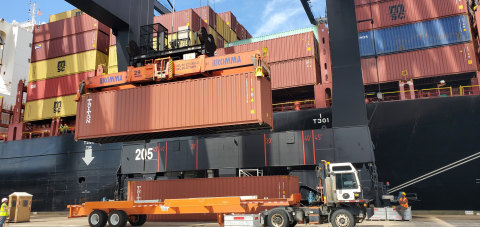HOUSTON--(BUSINESS WIRE)--The Port Commission of the Port of Houston Authority met Tuesday for its regular monthly meeting. Port Houston Chairman Ric Campo opened the meeting by expressing his appreciation for all “the people working together to keep the cargo moving.”
Chairman Campo acknowledged the unprecedented challenges that increased demand in the supply chain has created, but “people show up every day working together to keep cargo moving.”
In his report to the Port Commission, Executive Director Roger Guenther said that Houston is not immune to the challenges that ports across the nation are experiencing, as retailers rebuild their inventory to meet high demand. He noted that Houston docks are full, and the average ship waits about 60 hours before calling the port. However, Port Houston has been able to mitigate significant impacts on truck-turn times despite the increase in historic cargo volumes.
Guenther said, “We are working together with labor to turn ships around as quickly as possible.” He said that since January, the International Longshoremen’s Association (ILA) has been able to increase the numbers of people working ships on both the day and night shifts.
Guenther said he expects “the inherent continued growth of cargo at a rapid pace after the pandemic,” and plans are to sustain the accelerated investment in infrastructure. During the meeting, the Port Commission approved a more than $2 million purchase of 16 additional energy-efficient yard tractors for the container yards, supported by a grant from the Seaport and Rail Yard Areas Emission Reduction Program (SPRY), to help reduce emissions of NOx by 93%.
The Port Commission also authorized up to $400 million bond issuance to support the Houston Ship Channel widening and deepening program, Project 11.
The next Port Commission meeting is Thursday, November 18.
About Port Houston
For more than 100 years, Port Houston has owned and operated the public wharves and terminals along the Houston Ship Channel, including the area’s largest breakbulk facility and two of the most efficient and fastest-growing container terminals in the country. Port Houston is the advocate and a strategic leader for the Channel. The Houston Ship Channel complex and its more than 200 public and private terminals, collectively known as the Port of Houston, is the nation’s largest port for waterborne tonnage and an essential economic engine for the Houston region, the state of Texas, and the U.S. The Port of Houston supports the creation of nearly 1.35 million jobs in Texas and 3.2 million jobs nationwide, and economic activity totaling $339 billion in Texas – 20.6 percent of Texas’ total gross domestic product (GDP) – and $801.9 billion in economic impact across the nation. For more information, visit the website at www.PortHouston.com.




